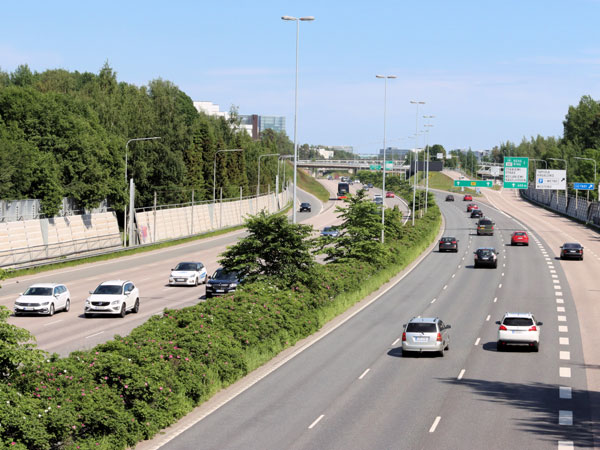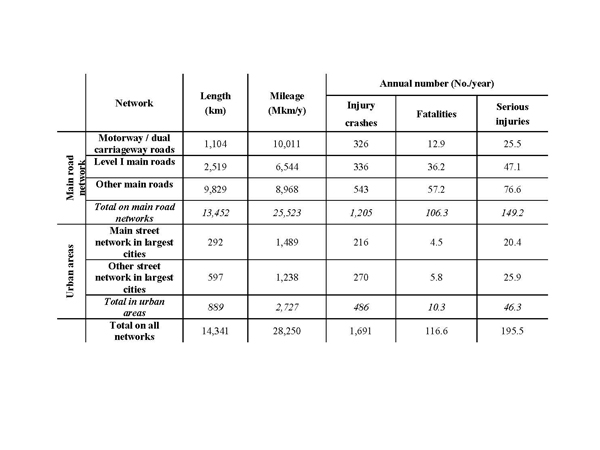A recent study identified the potentially affected accidents by conditionally automated vehicles (SAE3) in Finland. The study was based on identifying the road network where the systems can be used and calculating the network’s current safety situation in terms of expected number of injury crashes, fatalities, and serious injuries.

Technological advances have enabled vehicles to become automated, i.e., able to take over part of the driving task. In conditionally automated vehicles (SAE3), the user is required to take over the driving task if the system cannot handle the situation. Furthermore, they can operate only within their operational design domain (ODD), which can include requirements related both to infrastructure and occurring conditions. Automation of road traffic has been proposed as one way to improve traffic safety, but the safety aspects of conditional automation are still rather unexplored. This study identified how many accidents conditionally automated vehicles can potentially affect in Finland. The methodological focus was on reliably identifying the systems’ target accidents, i.e., the maximum number of accidents that could be affected. The study was limited to passenger cars with (SAE3) automated driving systems (ADS) for motorways and urban areas.
Methodological approach
This study derived from first identifying the road network where ADS can be used, and then modelling the current safety situation using the Empirical Bayes method. Using the expected number of accidents eliminates the random variation of accident records and is especially important when investigating different severities separately since it requires splitting accident records into even smaller groups.
The ODD requirements for motorway (motorways and physically separated roads; speed up to 130 km/h; no heavy precipitation or fog; no icy conditions) and urban ADS (main streets, speed up to 50 km/h; no heavy precipitation or fog; no icy conditions) were based on the mature system descriptions developed within the European L3Pilot project. The network for motorway ADS included all motorway and dual-carriageway road sections. Due to data availability, the network for urban ADS included the main streets in the metropolitan area (cities of Helsinki, Espoo, and Vantaa) and the city of Turku.
The calculations of the current safety situation for the main road networks were done with the TARVA tool (http://www.tarva.net) which has been under continual development since 1994, and can estimate the expected number of injury crashes, fatalities, and serious injuries for any selected main road section. For the street networks, the calculations were done adhering to the same methodology applied in TARVA.

To calculate the fraction of potentially affected crashes, the number of potentially affected accidents was proportioned to the overall 5–6 year average in the country (5,816 injury crashes, 241 fatalities, and 470 serious injuries) and in the selected cities for urban ADS (727 injury crashes, 15.4 fatalities, and 44.6 serious injuries).
Potentially affected accidents
According to the results, motorway ADS can potentially affect annually 191 injury accidents, eight fatalities, and fifteen serious injuries, which corresponds to 3.3% of all injury accidents, 3.1% of all fatalities, and 3.2% of all serious injuries in Finland. In the four largest cities in Finland, urban ADS can potentially affect annually 127 injury accidents, three fatalities, and twelve serious injuries. Compared to the country’s annual average, this corresponds to 2.2% of injury accidents, 1.1% of fatalities, and 2.5% of serious injuries. Compared to the selected cities’ annual average, this corresponds to 17.4% of injury accidents, 17.1% of fatalities, and 26.8% of serious injuries.
Currently, the use of motorway ADS in Finland would be severely restricted by the requirement for physically separated driving directions, given that roughly only 1.5% of the main road network is physically separated. Should the development of ADS technology move towards including high-level rural roads in their ODD, their operating environment could be substantially extended. Due to data availability, the urban ADS analysis was limited to the four largest cities. However, urban ADS could be used also in other cities, indicating that the potential could be substantially greater.
The research leading to these results has received funding from the European Commission Horizon 2020 program under the project L3Pilot, grant agreement number 723051. Responsibility for the information and views set out in this publication lies entirely with the authors.
Text: Fanny Malin/VTT.
Read more:
Fanny Malin, Anne Silla, Johannes Mesimäki, Satu Innamaa & Harri Peltola (2022). Identifying crashes potentially affected by conditionally automated vehicles in Finland. Journal of Intelligent Transportation Systems, published online 29 May 2022.
Contact

Fanny Malin
fanny.malin@vtt.fi
VTT Technical Research Centre of Finland Ltd., Finland






Follow us: